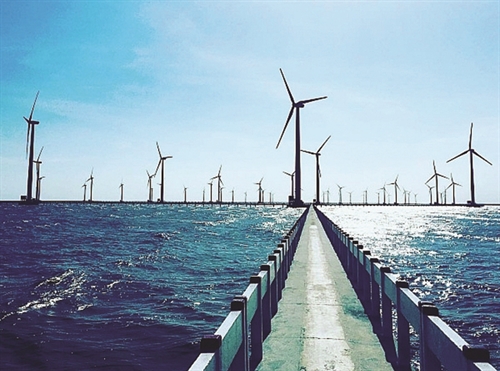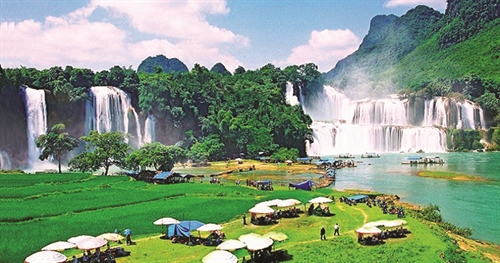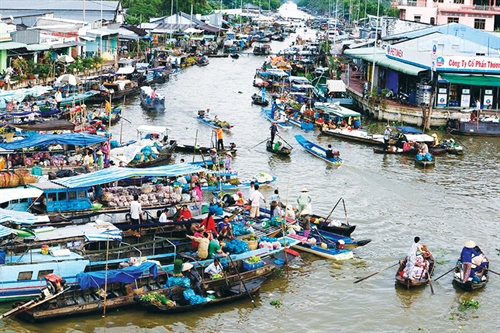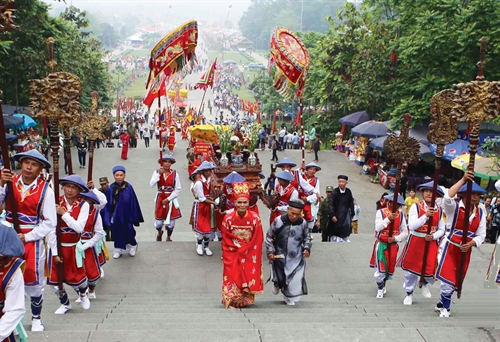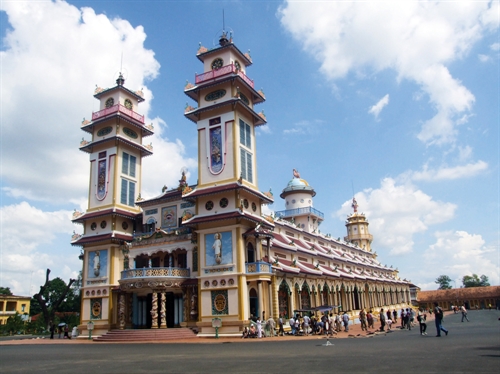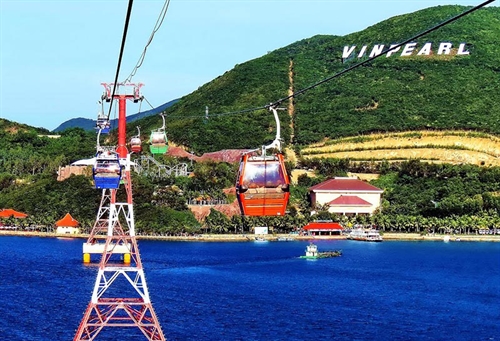Located in the northwestern mountainous region, Lao Cai province borders Ha Giang province to the east, Son La and Lai Chau provinces to the west, Yen Bai province to the south and China’s Yunnan province to the north with a borderline of 203km. Covering over 6,380 square kilometers (some 2.44 percent of the country’s total area), Lao Cai has a population of 674,530 (according to the 2016 statistics) and is home to Kinh (Viet) people as the most populous and 24 other ethnic groups such as Hmong, Tay, Dao, Giay, Nung and Phu La. It has a provincial city with the same name and eight districts of Bao Thang, Bao Yen, Bac Ha, Si Ma Cai, Muong Khuong, Sa Pa, Bat Xat and Van Ban.
There are five national highways with a total length of 451km and two rivers, Red and Chay, running through the province. The 265-km Noi Bai-Lao Cai expressway helps shorten the travel time between Hanoi and Lao Cai from seven to three and a half hours. The route is also linked with Kunming-Hekou highway of China by Kim Thanh bridge, thus facilitating smooth transportation on the Kunming-Lao Cai-Ha Noi-Hai Phong economic corridor, one of the most important free trade routes between ASEAN member nations and China. In addition, the Hai Phong-Hanoi-Lao Cai railway is connected with China’s Kunming-Hekou railway. The Lao Cai international border gate helps promote trade ties between the province and China’s southwestern region in general and Yunnan province in particular.
The province is one of the country’s richest localities in mineral resources with 35 minerals and some 150 mines that are favorable for the development of mining and processing industry.
Moves to lure foreign investment in hi-tech agriculture
In 2018, Lao Cai ranked 12th among 63 provinces and cities in the provincial competitiveness index (PCI).
At present, the province is home to three industrial parks covering a total area of 1,285 ha and a 15,929 ha border-gate economic zone.
Nguyen Khanh Toan, Deputy Head of the provincial Planning and Investment Department’s External Economic Affairs Section, told Vietnam Law and Legal Forum magazine that Lao Cai has so far attracted 20 foreign direct investment (FDI) projects, including 12 from China, three from Singapore, two from the Republic of Korea (RoK), and other three from Denmark, Norway, the UK and the US, with a combined registered capital of USD 540 million. Those projects are specialized in mining, processing and tourism services.
According to Toan, China is the top investor representing 72 percent of the province’s FDI figures. Worthy of note are the USD 337.5 million Quy Sa iron ore mining and Lao Cai iron and steel mill project - a joint venture between the Vietnam Steel Corporation and China’s Kungang steel and iron company; and the 21-MW Seo Chong Ho hydropower plant project which is a USD 35 million joint venture between the Northern Power Corporation and China’s Yunnan Power Grid Co.
In particular, the USD 75 million five-star Aristo hotel project of Singapore and the USD 15 million four-star Victoria hotel project from Hong Kong (China) are two effectively operating FDI projects in the province, said Toan, adding that Denmark’s Topas Ecolodge Company plans to increase its investment capital from USD 3.3 million to USD 9.2 million for its hotel business and service project.
At present, RoK and Japanese investors are willing to implement two FDI projects on hi-tech agriculture and intensive farm produce processing in the province.
He said Lao Cai is planning to attract FDI capital to mineral intensive processing, tourism and logistics this year and organize the 2019 investment, trade and tourism promotion conference in May.
For the 2016-2020 period, the province is calling for investment in copper and iron processing; tourism in Sa Pa and Bac Ha districts; hi-tech agriculture in Sa Pa, Bac Ha, Bao Thang and Bat Xat districts; logistics and warehousing in Lao Cai border-gate economic zone.
In order to attract more investors, the Lao Cai People’s Committee has pledged to shorten the time required for completion of administrative formalities, assist investors in ground clearance, and simplify investment, tax and customs procedures.
In addition to the Government-provided preferential treatment, the provincial administration has offered numerous incentives. Normal projects will be exempted from land rental for seven years while those investing in the investment priority sectors will enjoy land rental exemption for 11 years. They will also be entitled to corporate income tax exemption for four years since the generation of taxable income and 50-percent tax reduction for subsequent nine years.
 |
| Lemongrass is well developed on infertile hills in Bao Thang district, Lao Cai province__Photo: Huong Thu/VNA |
Lao Cai - land of four-season tourism festivals
Listed among the top 10 most beautiful places in the world by theRichest, the world’s leading entertainment and lifestyle website, Lao Cai is famous for festivals all year round such as the Bac Ha temple festival in Bac Ha district and the long tong (going-to-the-field) festival of the Tay ethnic group in the spring; the festival in the clouds in Sa Pa district and the traditional horse race in Bac Ha district in the summer; the international mountain marathon and the Vietnam Mountain Bike Marathon in the fall; the Sa Pa winter festival and the Sa Pa’s Snow Days in the winter. The province is also well-known for Muong Hoa valley - a breathtaking picture of nature, Ta Phin village and traditional herb baths of the Red Dao ethnic group and traditional craft villages. Among the best known are the brocade and embroidery village in Ngai Tro village, Y Ty commune, Bat Xat district and Ni Xin village, Pha Long commune, Muong Khuong district and the silver carving village in Seo Po Ho village, Muong Hum commune, Bat Xat district. As many as 15 types of brocade products made by ethnic women in Nam Sai commune, Sa Pa district, have been exported to Australia, France, Italy and the US.
Sa Pa district is recommended to tourists by the US travel site thrillist.com as a must-see place in 2018 with spectacular terraced rice fields, poetic valleys and diverse cultures of ethnic groups. It has recently been listed among top 10 enthralling travel destinations in Southeast Asia voted by readers of the London-based travel site Rough Guides and one of the 10 best walking sites in the world for tourists by Australian travel magazine Lonely Planet. Sa Pa is home to Kinh, Hmong, Dao, Tay, Giay and Xa Pho ethnic groups and famous for lovers’ markets, lush vegetation, Fansipan mountain - the highest peak in Indochina, strange carved stones and traditional thang co - hot pot with a mixture of horse meat and internal organs.
According to Ha Van Thang, Director of the Lao Cai Culture, Sports and Tourism Department, the four-season tourism festival has been promoted into a new tourism brand to advertise Lao Cai’s cultural characteristics and natural beauty.
To develop the hospitality sector into its economic spearhead, Lao Cai province has prioritized attracting investment into potential areas, including Sa Pa, Bac Ha, Bat Xat districts and Lao Cai city. It has set up the Lao Cai Tourism Information and Promotion Center to provide tourist information on three websites sapa-tourism.com in Vietnamese and English, dulichlaocai.vn in Vietnamese, English and Chinese, and dulichtaybac.vn in Vietnamese. The center has also organized various courses for tourist guides, hotel and restaurant staff and homestay service caters.
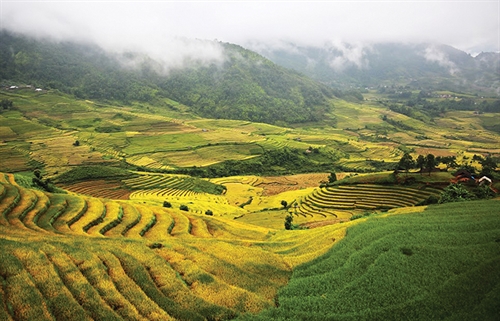 |
| Terrace rice fields in Bat Xat district, Lao Cai province, during harvest season __Photo: Internet |
Regarding Lao Cai’s plan to upgrade Sa Pa district into a town, Prime Minister Nguyen Xuan Phuc has highlighted Lao Cai’s upgrading determination and asked the province to keep good management of Sa Pa, preserve ethnic groups’ culture, protect and develop forests, ensure national defense, promote solidarity among local people, and maintain its image as a hospitable destination.
The Lao Cai Culture, Sports and Tourism Department has recently revealed that the province has roughly one thousand hotels and guest houses. The hospitality sector attracted some 718,500 foreign arrivals and raked in a tourism turnover of VND 13.4 trillion (roughly USD 582.8 million) last year. In the reviewed period, Sa Pa alone welcomed more than 7,600 foreign tourist arrivals.
The above results are partly attributable to diverse tours and tourist products, upgraded tourist infrastructure facilities and the wide application of community-based tourism and homestay models.
With over 200 homestay facilities across the province, Lao Cai has received the ASEAN homestay award that is presented based on location, management, safety and security among other criteria.
The province expects to receive five million tourist arrivals, including around 900,000 foreign arrivals and earn a turnover of VND 19 trillion (roughly USD 826 million) this year.
To achieve the target, the province plans to develop high-quality local human resources for community-based tourism services as well as lure qualified tourism resources from other localities to work in the province.
Ha Van Thang told the local online newspaper that in the coming time, the department would attract resources for developing transport infrastructure linking tourist sites and speed up the construction of big projects such as the Sa Pa hotel, restaurant, park complex project. It will also assist organizations and enterprises in seeking investment opportunities and organize meetings and dialogues with tourism companies to help the latter remove their difficulties, he added.- (VLLF)

